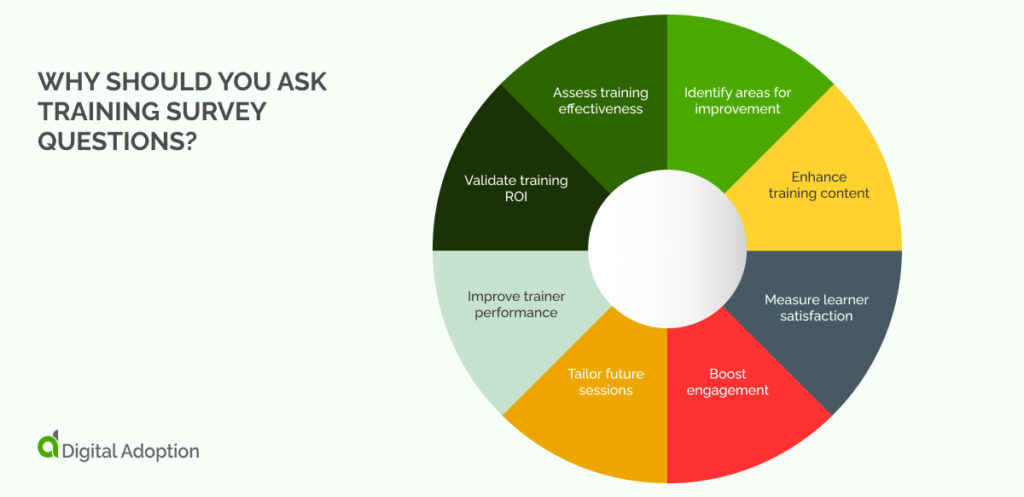A gap can sometimes exist between C-suites and team members that drive the tasks that keep an organization profitable.
Training survey questions help bridge that gap by determining what employees think of every aspect of their training and its impact on them and their organization. This data is also crucial for training program sponsors and leaders to improve their training.

Asking staff how they feel about their training isn’t just about equipping them with skills. It can also show employees that their organization cares about their progress. This point can drive employee retention, as 93% of staff consider departing when their organization doesn’t show interest in their professional development.
This article will present you with ninety-nine survey training questions to ask your staff. We will start with a definition, move on to the list of valuable questions, and then focus on why you should ask these questions.
You will come away with a strong understanding of what questions to ask and their value in improving the digital employee experience and productivity through on-site and remote training for better revenue.
What are training survey questions?
Training survey questions are questions training program sponsors and leaders ask their staff to ensure they are optimizing training quality.
These questions can cover many aspects and stages of training, like pre-training experiences, learning environment, training software, accessibility, and effectiveness. Examples include “What improvements would you suggest?” and “How confident are you in applying what you’ve learned?”
Training survey questions enhance content, improve delivery methods, and boost learner engagement and retention.
99 Training survey questions
Consider the questions below, which cover every aspect of employee training, from pre-training experiences to every part of the post-training experience.
These questions help you build a detailed picture of your staff’s needs, enabling you to begin to action them with better training in the future. They can also help you consider increasing employee onboarding through better new-hire training.
Questions on the pre-training experience
These questions ensure employees are adequately prepared, setting the stage for a productive learning experience by identifying gaps in communication and preparation.
- Was the purpose of this training program clear to you at the beginning of the course?
- How did you learn about the upcoming training? (email, manager, HCM software alert)
- Was the purpose of the training program communicated to you beforehand?
- Did you receive sufficient notice and preparation time for the training?
- Were the training objectives and outcomes clearly defined before the course began?
- Was the registration process for the training easy?
- Did you receive a detailed training schedule and agenda in advance?
- Did you receive any pre-training materials or resources? If so, were they helpful?
- Was the training location and time convenient? Did you receive remote training options?
- Were you informed about what to bring or prepare for the training session?
- Did you feel adequately prepared to participate in the training?
- Were you aware of who to contact for questions or issues before the training?
- Was the communication regarding the training timely and effective?
- Did you set appropriate expectations before attending?
- Do you have any suggestions for improving the pre-training communication and preparation process?
Use these responses to improve communication, adjust preparation timelines, and streamline training registration processes.
Questions on the learning experience, environment, and delivery
Reviewing and evaluating the training environment and delivery method ensures they are conducive to effective learning and engagement.
Employee engagement survey questions should also be considered when collecting engagement data alongside these training questions.
- Did the training fulfill your expectations?
- What did you enjoy most about the training?
- How would you rate the overall quality of this training session?
- Was the training program interactive and engaging?
- Did the training feel too fast or slow?
- Was the training location comfortable?
- Was the training environment or remote learning home environment conducive to learning? (e.g., quiet/loud, cold/hot, etc.)
- Did you have opportunities to collaborate with your team members? If so, was it effective?
- Was the number of learners in the session appropriate?
- Were you given enough time and resources to complete the training?
- What is the best delivery method for future training for this course: in-person instruction or online eLearning?
- Do you have any suggestions for improving the learning experience or environment for future training workshops?
Take note of the responses to this survey section to enhance learning environments, adjust delivery methods, and provide better resources.
Questions on the instructor
Assessing instructor performance helps ensure the trainer’s knowledge, delivery, and engagement meet learners’ needs.
- How would you rate the overall performance of the training instructor?
- How would you specifically rate the instructor’s teaching quality?
- Was the instructor knowledgeable about the topic?
- Did the instructor show enthusiasm?
- Was the instructor friendly?
- Was the trainer engaging and supportive?
- Was the instructor easy to understand? (e.g., clear speech, appropriate volume, minimal slang)
- Did the instructor provide practical examples to apply the training material?
- Did the instructor prepare activities?
- Did the instructor facilitate communication and engagement among learners?
- Was the instructor well-prepared and organized?
- Did the instructor give clear instructions throughout the lesson?
- Did the instructor provide feedback? Was it individualized or directed to the overall group?
- Do you have any additional feedback on this instructor and what they could have done more effectively?
- Do you have any suggestions for future instructors?
Look at these survey responses to inform future instructor training, gather constructive feedback, and improve engagement techniques.
Questions on the training content, modules, and structure
Feedback on training content and structure ensures the material is relevant, comprehensive, and logically organized.
- Was the training program well-organized and easy to follow?
- Did you find the training material practical, intuitive, and helpful?
- Was the training material and examples inclusive of all backgrounds?
- Did you find the medium of instruction (e.g., PPT, LMS, video) effective?
- Was the training material easy to understand?
- Was the study material personalized to help solve problems specific to your job requirements?
- Were all modules engaging and interesting? If not, which modules were not engaging?
- Did the training modules flow well?
- Were you satisfied with the learning content and material?
- Were there enough visual aids?
- Was there sufficient video and audio content?
- Did the training content provide enough context and detail?
- What was your favorite training activity? What was your least favorite?
- What medium should this training use for future lessons? (e.g., PPT, LMS, video)
- Was the training content sufficient? What could be added or improved?
Collecting and examining data on training content, modules, and structure allows you to update content, restructure modules, and ensure relevance and depth.
Questions on the technology and online training
Evaluating learning technologies from the staff’s perspective ensures support for effective learning without technical barriers.
- Have you experienced online training before?
- Did the online training application provide enough guidance on how to use the platform?
- Did you find any specific difficulties with this online training?
- Is this online training more effective than traditional, instructor-led training?
- Was the LMS / online training portal easy to use?
- Did you experience any trouble using the training software’s interface?
- Was it easy to navigate?
- Were there any broken links or missing images, videos, or audio clips in the online training?
- Did you experience any bugs, glitches, or slow load times?
- How could we improve the online training experience?
Examine the responses to this survey section and use them to upgrade technology, provide technical support, and ensure platform accessibility.
Also, consider the advantages and limitations of LMS vs. DAP when choosing learning technology.
Questions on accessibility
Ensuring training accessibility questions guarantees that all employees, regardless of ability, can fully participate and benefit from the training. If any aren’t able to participate, survey responses ensure you are aware and can take action to correct this.
- Was the training location physically accessible to you?
- Were the training materials available in accessible formats (large print, Braille, or digital)?
- Did the online training platform support screen readers and other assistive technologies?
- Was closed captioning available for video content?
- Were transcripts provided for all audio and video materials?
- Did you have any issues with the readability of the text (e.g., font size, contrast)?
- Were you able to easily navigate the training platform?
- Did the training include any alternative formats for visual content (e.g., descriptive audio)?
- Were sign language interpreters available if needed?
- Did any physical barriers in the training environment (stairs, narrow doorways) exist?
- Was the training venue equipped with assistive listening devices?
- Did the training materials accommodate different learning styles (e.g., visual, auditory, kinesthetic)?
- Did you receive enough time to complete all training modules and activities?
- What are your thoughts on the pacing of the training?
- Did you have access to ergonomic seating and workspaces?
- Were there accessible restrooms available at the training location?
- Were you able to request and receive any necessary accommodations in advance?
- Did the instructor provide clear and accessible instructions?
- Were there any distractions or obstacles that affected your ability to focus on the training?
- Do you have any suggestions for improving the accessibility of future training sessions?
Utilize data from this survey section to implement accommodations, ensure accessible material formats, and provide assistive technologies like magnification tools or screen-reading software.
Questions on training effectiveness
Measuring training effectiveness with your surveys ensures that it meets its objectives and positively impacts job performance.
- Were all your questions answered during the training?
- How would you rate the quality of this training session?
- What are your professional goals for learning and development? Did this training help you achieve these goals?
- Was the training relevant to your current or potential job?
- After completing the training, do you feel competent and confident in the topic? Please share any concerns or knowledge gaps.
- Did the training provide in-depth material coverage or only cover the basics?
- What additional topics or areas do you wish the training had explored more?
- Does this training require a follow-up session?
- How much of the training do you think you’ll retain?
- Should this training be provided regularly, or was one session sufficient?
- Overall, did the course meet your expectations?
- Is there anything else you want to share about this training?
Use the responses to these survey questions to adjust training objectives, implement feedback, and measure performance improvements.
Why should you ask training survey questions?

Before building a survey, ask yourself: why are we doing this? The value of training surveys is limited to the reasons you want to conduct them.
If you are clear on why you are doing the survey, you will ensure better data collection, and it will become easier to act on the responses to achieve the desired results.
Assess training effectiveness
Assessing training effectiveness helps enterprises determine if the training meets its objectives.
For instance, a tech company can ask employees if they can now resolve software issues more efficiently after a troubleshooting workshop. Positive feedback indicates success, while gaps suggest a need for further training. This approach ensures the training program delivers tangible benefits.
Identify areas for improvement
Identifying areas for improvement allows enterprises to fine-tune their training programs. For example, through surveys, a retail chain may discover that staff find customer service modules lacking in real-life scenarios. By pinpointing this gap, the company can update the training to include practical role-plays, enhancing employees’ readiness for actual customer interactions.
Enhance training content
Enhancing training content based on feedback ensures relevance and engagement. For example, a financial institution might learn that employees find compliance training too theoretical.
Using this insight, they can incorporate interactive case studies and real-world examples, making the training more engaging and practical. This engagement leads to better knowledge retention and application in daily tasks.
Measure learner satisfaction
Measuring learner satisfaction helps gauge the overall reception of the training. For example, an enterprise software firm can survey participants post-training to see if they found the new system training helpful. High satisfaction rates indicate effective training, while low scores highlight a need for adjustments, ensuring employees feel supported and valued.
Boost engagement
Boosting engagement through survey feedback ensures employees remain interested and motivated.
One example may be a healthcare organization that might discover through surveys that interactive elements like quizzes and group discussions increase engagement in training sessions. Implementing these elements based on feedback keeps the training dynamic and employees actively involved, enhancing learning outcomes.
Tailor future sessions
Tailoring future sessions based on survey results ensures training remains relevant to employees’ needs. A manufacturing company might learn that employees want more advanced safety training. By incorporating these requests, the company ensures future sessions address specific needs, leading to more effective and valued training programs.
Improve trainer performance
Improving trainer performance through feedback ensures high-quality delivery. For example, a global consultancy can ask participants to rate the trainer’s knowledge and presentation skills. Constructive feedback helps trainers refine their methods, leading to more effective training sessions and better learner outcomes, ultimately benefiting the organization.
Validate training ROI
Validating training ROI through surveys helps justify training investments. For instance, a telecommunications company can assess if sales training has led to increased customer acquisitions.
Positive feedback and improved sales metrics demonstrate a clear return on investment, supporting continued funding and development of training programs to drive business success.
Consider these reasons for asking training survey questions to help you assess the value of conducting surveys.
Follow-up survey questions with actions
Enterprises must follow up on survey questions with tangible actions. It is vital to address employees’ suggestions and concerns when they provide feedback on training sessions.
For instance, if survey results highlight a need for more hands-on activities, promptly incorporating these changes shows responsiveness.
This approach improves training programs and boosts employee morale and trust. By demonstrating a commitment to continuous improvement, enterprises can create a more effective, engaging, and adaptive training environment that aligns with employees’ needs.
Also, consider other types of surveys alongside these training questions, like employee satisfaction survey questions, to help build a complete picture of employee experience and incentivize your staff to optimize their organizational performance.













